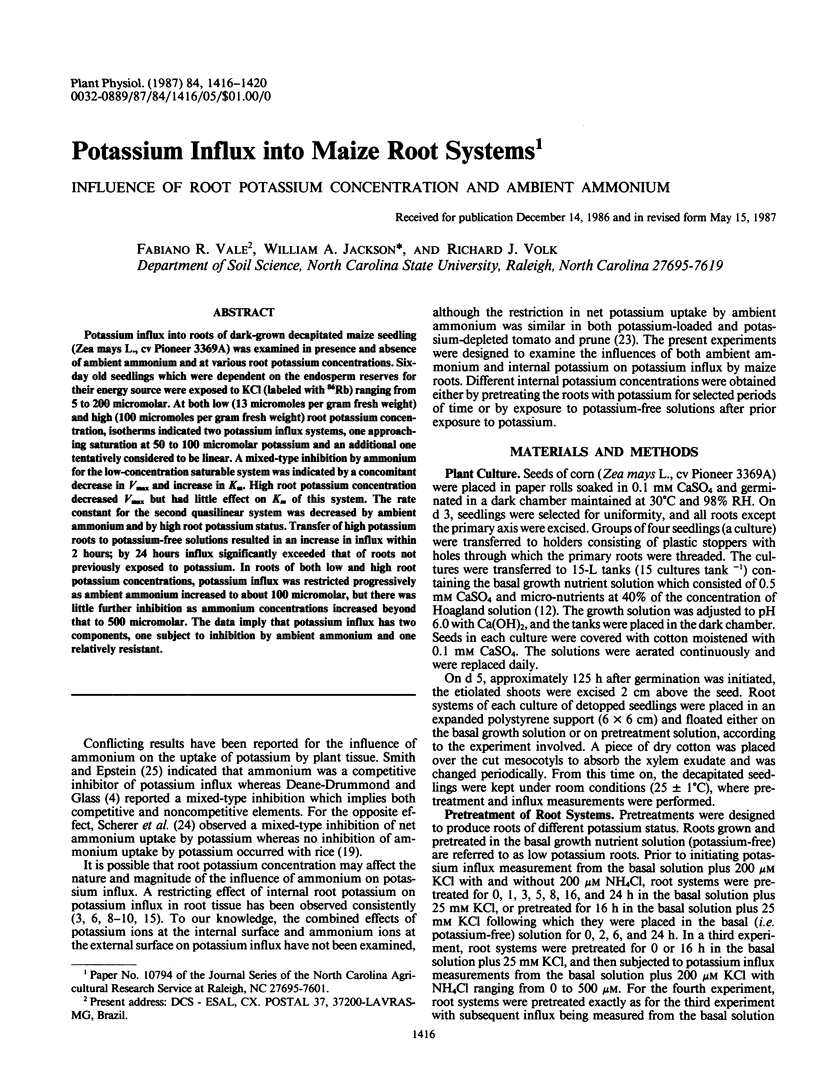Abstract
Potassium influx into roots of dark-grown decapitated maize seedling (Zea mays L., cv Pioneer 3369A) was examined in presence and absence of ambient ammonium and at various root potassium concentrations. Six-day old seedlings which were dependent on the endosperm reserves for their energy source were exposed to KCl (labeled with 86Rb) ranging from 5 to 200 micromolar. At both low (13 micromoles per gram fresh weight) and high (100 micromoles per gram fresh weight) root potassium concentration, isotherms indicated two potassium influx systems, one approaching saturation at 50 to 100 micromolar potassium and an additional one tentatively considered to be linear. A mixed-type inhibition by ammonium for the low-concentration saturable system was indicated by a concomitant decrease in Vmax and increase in Km. High root potassium concentration decreased Vmax but had little effect on Km of this system. The rate constant for the second quasilinear system was decreased by ambient ammonium and by high root potassium status. Transfer of high potassium roots to potassium-free solutions resulted in an increase in influx within 2 hours; by 24 hours influx significantly exceeded that of roots not previously exposed to potassium. In roots of both low and high root potassium concentrations, potassium influx was restricted progressively as ambient ammonium increased to about 100 micromolar, but there was little further inhibition as ammonium concentrations increased beyond that to 500 micromolar. The data imply that potassium influx has two components, one subject to inhibition by ambient ammonium and one relatively resistant.
Full text
PDF




Selected References
These references are in PubMed. This may not be the complete list of references from this article.
- Deane-Drummond C. E., Glass A. D. Short Term Studies of Nitrate Uptake into Barley Plants Using Ion-Specific Electrodes and ClO(3): II. Regulation of NO(3) Efflux by NH(4). Plant Physiol. 1983 Sep;73(1):105–110. doi: 10.1104/pp.73.1.105. [DOI] [PMC free article] [PubMed] [Google Scholar]
- Epstein E., Rains D. W., Elzam O. E. RESOLUTION OF DUAL MECHANISMS OF POTASSIUM ABSORPTION BY BARLEY ROOTS. Proc Natl Acad Sci U S A. 1963 May;49(5):684–692. doi: 10.1073/pnas.49.5.684. [DOI] [PMC free article] [PubMed] [Google Scholar]
- Glass A. D. Regulation of potassium absorption in barley roots: an allosteric model. Plant Physiol. 1976 Jul;58(1):33–37. doi: 10.1104/pp.58.1.33. [DOI] [PMC free article] [PubMed] [Google Scholar]
- HOFSTEE B. H. J. On the evaluation of the constants Vm and KM in enzyme reactions. Science. 1952 Sep 26;116(3013):329–331. doi: 10.1126/science.116.3013.329. [DOI] [PubMed] [Google Scholar]
- Kochian L. V., Lucas W. J. Potassium Transport in Corn Roots : II. The Significance of the Root Periphery. Plant Physiol. 1983 Oct;73(2):208–215. doi: 10.1104/pp.73.2.208. [DOI] [PMC free article] [PubMed] [Google Scholar]
- Kochian L. V., Lucas W. J. Potassium transport in corn roots : I. Resolution of kinetics into a saturable and linear component. Plant Physiol. 1982 Dec;70(6):1723–1731. doi: 10.1104/pp.70.6.1723. [DOI] [PMC free article] [PubMed] [Google Scholar]
- Läuchli A., Epstein E. Transport of potassium and rubidium in plant roots: the significance of calcium. Plant Physiol. 1970 May;45(5):639–641. doi: 10.1104/pp.45.5.639. [DOI] [PMC free article] [PubMed] [Google Scholar]
- Pan W. L., Jackson W. A., Moll R. H. Nitrate Uptake and Partitioning by Corn Root Systems : Differential Effects of Ammonium among Genotypes and Stages of Root Development. Plant Physiol. 1985 Mar;77(3):560–566. doi: 10.1104/pp.77.3.560. [DOI] [PMC free article] [PubMed] [Google Scholar]
- Smith R. C., Epstein E. Ion Absorption by Shoot Tissue: Kinetics of Potassium and Rubidium Absorption by Corn Leaf Tissue. Plant Physiol. 1964 Nov;39(6):992–996. doi: 10.1104/pp.39.6.992. [DOI] [PMC free article] [PubMed] [Google Scholar]
- WILKINSON G. N. Statistical estimations in enzyme kinetics. Biochem J. 1961 Aug;80:324–332. doi: 10.1042/bj0800324. [DOI] [PMC free article] [PubMed] [Google Scholar]


